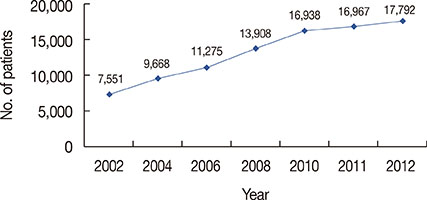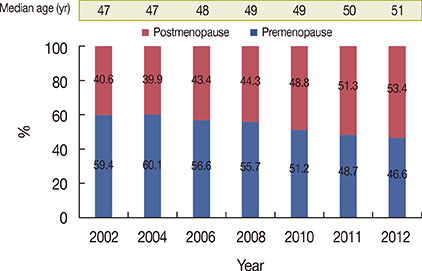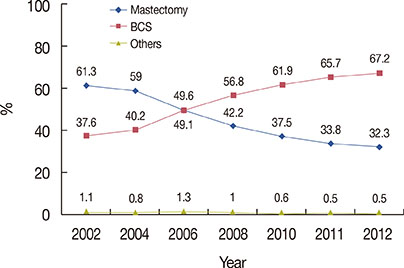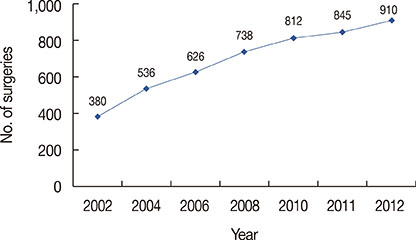The Basic Facts of Korean Breast Cancer in 2012: Results from a Nationwide Survey and Breast Cancer Registry Database
- Affiliations
-
- 1Department of Surgery, Soonchunhyang University Bucheon Hospital, Soonchunhyang University College of Medicine, Bucheon, Korea.
- 2Department of Surgery, Kyung Hee University Medical Center, Kyung Hee University School of Medicine, Seoul, Korea.
- 3Department of Surgery, Cheil General Hospital and Women's Healthcare Center, Dankook University College of Medicine, Seoul, Korea. hmh1916@gmail.com
- 4The Korea Central Cancer Registry, Division of Cancer Registration and Surveillance, National Cancer Center, Goyang, Korea.
- 5Department of Surgery, Asan Medical Center, University of Ulsan College of Medicine, Seoul, Korea.
- 6Department of Surgery, Seoul National University Bundang Hospital, Seoul National University College of Medicine, Seongnam, Korea.
- 7Department of Surgery, Samsung Medical Center, Sungkyunkwan University School of Medicine, Seoul, Korea.
- 8Department of Surgery, Biomedical Research Institute, Pusan National University Hospital, Busan, Korea.
- KMID: 2374524
- DOI: http://doi.org/10.4048/jbc.2015.18.2.103
Abstract
- The Korean Breast Cancer Society has constructed a nationwide breast cancer database through utilization of an online registration program. We have reported the basic facts about breast cancer in Korea in 2012, and analyzed the changing patterns in the clinical characteristics and management of breast cancer in Korea over the last 10 years. Data on patients newly diagnosed with breast cancer were collected for the year 2012 from 97 hospitals and clinics nationwide using a questionnaire survey, and from the online registry database. A total of 17,792 patients were newly diagnosed with breast cancer in 2012. The crude incidence rate of female breast cancer, including invasive cancer and in situ cancer, was 70.7 cases per 100,000 women. The median age at diagnosis was 51 years, and the proportion of postmenopausal women was higher than that of premenopausal women among those diagnosed with breast cancer. The proportion of cases of early breast cancer increased continuously, and breast-conserving surgery was performed in more cases than total mastectomy in that same year. The total number of breast reconstruction surgeries increased approximately 3-fold over last 10 years. The 5-year overall survival rate for all stages of breast cancer patients was extremely high. The clinical characteristics of breast cancer have changed in ways that resulted in high overall survival over the past 10 years in Korea, and the surgical management of the disease has changed accordingly. Analysis of nationwide registry data will contribute to a better understanding of the characteristics of breast cancer in Korea.
Keyword
MeSH Terms
Figure
Cited by 13 articles
-
The Basic Facts of Korean Breast Cancer in 2013: Results of a Nationwide Survey and Breast Cancer Registry Database
Sun Young Min, Zisun Kim, Min Hee Hur, Chan Seok Yoon, Eun-Hwa Park, Kyu-Won Jung,
J Breast Cancer. 2016;19(1):1-7. doi: 10.4048/jbc.2016.19.1.1.Oncologic Safety of Immediate Breast Reconstruction for Invasive Breast Cancer Patients: A Matched Case Control Study
Shin-Hoo Park, Wonshik Han, Tae-Kyung Yoo, Han-Byoel Lee, Ung Sik Jin, Hak Chang, Kyung Won Minn, Dong-Young Noh
J Breast Cancer. 2016;19(1):68-75. doi: 10.4048/jbc.2016.19.1.68.Basic Facts of Breast Cancer in Korea in 2014: The 10-Year Overall Survival Progress
Eun Hwa Park, Sun Young Min, Zisun Kim, Chan Seok Yoon, Kyu-Won Jung, Seok Jin Nam, Se Jeong Oh, Seeyoun Lee, Byeong-Woo Park, Woosung Lim, Min Hee Hur,
J Breast Cancer. 2017;20(1):1-11. doi: 10.4048/jbc.2017.20.1.1.Two different views of interpreting the related evidences on the reply to reader's letter
Jong-Myon Bae
J Korean Med Assoc. 2015;58(12):1196-1197. doi: 10.5124/jkma.2015.58.12.1196.It needs adaptation to the 2015 Korean guideline for breast cancer screening
Jong-Myon Bae
J Korean Med Assoc. 2015;58(9):833-837. doi: 10.5124/jkma.2015.58.9.833.It needs adaptation to the 2015 Korean guideline for breast cancer screening
Jong-Myon Bae
J Korean Med Assoc. 2015;58(9):833-837. doi: 10.5124/jkma.2015.58.9.833.Current Domestic Research Trends for Exercise Intervention for Patients with Breast Cancer Undergoing Chemotherapy or Radiotherapy
Hyun Joo Lee, You Lee Yang, Sang Hui Chu
Asian Oncol Nurs. 2015;15(4):185-192. doi: 10.5388/aon.2015.15.4.185.Utility of Regular Radiological Follow-up on Early Detection of Contralateral Malignancy and Long-term Outcomes in Metachronous Bilateral Breast Cancer Patients
Hyo Sun Kim, Sun Hee Kang
Kosin Med J. 2017;32(1):72-83. doi: 10.7180/kmj.2017.32.1.72.Changes in Korean National Healthcare Insurance Policy and Breast Cancer Surgery Trend in Korea
Musaed Rayzah, Jai Min Ryu, Jun-Hee Lee, Seok Jin Nam, Seok Won Kim, Se Kyung Lee, Jonghan Yu, Kyeong-Tae Lee, Sa-Ik Bang, Goo-Hyun Mun, Jai-Kyong Pyon, Byung-Joon Jeon, Jeong Eon Lee
J Korean Med Sci. 2021;36(29):e194. doi: 10.3346/jkms.2021.36.e194.Risk Factors Associated with Endometrial Pathology in Premenopausal Breast Cancer Patients Treated with Tamoxifen
Maria Lee, Jinlan Piao, Myung Jae Jeon
Yonsei Med J. 2020;61(4):317-322. doi: 10.3349/ymj.2020.61.4.317.Basic Findings Regarding Breast Cancer in Korea in 2015: Data from a Breast Cancer Registry
Sang Yull Kang, Yoo Seok Kim, Zisun Kim, Hyun-Yul Kim, Se Kyung Lee, Kyu-Won Jung, Hyun Jo Youn,
J Breast Cancer. 2018;21(1):1-10. doi: 10.4048/jbc.2018.21.1.1.Perceptions of Quality of Patient-Centered Nursing Care among Women with Breast Cancer
Jiyoung Kang, Eunyoung E Suh
Perspect Nurs Sci. 2015;12(2):115-123. doi: 10.16952/pns.2015.12.2.115.Efficacy of Letrozole as First-Line Treatment of Postmenopausal Women with Hormone Receptor–Positive Metastatic Breast Cancer in Korea
Seung Hoon Beom, Jisu Oh, Tae-Yong Kim, Kyung-Hun Lee, Yaewon Yang, Koung Jin Suh, Hyeong-Gon Moon, Sae-Won Han, Do-Youn Oh, Wonshik Han, Tae-You Kim, Dong-Young Noh, Seock-Ah Im
Cancer Res Treat. 2017;49(2):454-463. doi: 10.4143/crt.2016.259.
Reference
-
1. Jung KW, Won YJ, Kong HJ, Oh CM, Shin A, Lee JS. Survival of Korean adult cancer patients by stage at diagnosis, 2006-2010: national cancer registry study. Cancer Res Treat. 2013; 45:162–171.
Article2. Siegel R, Ma J, Zou Z, Jemal A. Cancer statistics, 2014. CA Cancer J Clin. 2014; 64:9–29.
Article3. Jung KW, Won YJ, Kong HJ, Oh CM, Lee DH, Lee JS. Cancer statistics in Korea: incidence, mortality, survival, and prevalence in 2011. Cancer Res Treat. 2014; 46:109–123.
Article4. Cancer statistics. National Cancer Information Center, Ministry of Health and Welfare;Accessed March 25th, 2015. http://www.cancer.go.kr.5. Korean Breast Cancer Society. Korean breast cancer data of 1996. J Korean Surg Soc. 1998; 55:621–635.6. Korean Breast Cancer Society. Korean breast cancer data of 1997. J Korean Cancer Assoc. 1999; 31:1202–1209.7. Ahn SH, Yoo KY. Korean Breast Cancer Society. Chronological changes of clinical characteristics in 31,115 new breast cancer patients among Koreans during 1996-2004. Breast Cancer Res Treat. 2006; 99:209–214.
Article8. Ko SS. Korean Breast Cancer Society. Chronological changing patterns of clinical characteristics of Korean breast cancer patients during 10 years (1996-2006) using nationwide breast cancer registration on-line program: biannual update. J Surg Oncol. 2008; 98:318–323.
Article9. Jung YS, Na KY, Kim KS, Ahn SH, Lee SJ, Park HK, et al. Nation-wide Korean breast cancer data from 2008 using the breast cancer registration program. J Breast Cancer. 2011; 14:229–236.
Article10. Ko BS, Noh WC, Kang SS, Park BW, Kang EY, Paik NS, et al. Changing patterns in the clinical characteristics of Korean breast cancer from 1996-2010 using an online nationwide breast cancer database. J Breast Cancer. 2012; 15:393–400.
Article11. Kim Z, Min SY, Yoon CS, Lee HJ, Lee JS, Youn HJ, et al. The basic facts of Korean breast cancer in 2011: results of a nationwide survey and breast cancer registry database. J Breast Cancer. 2014; 17:99–106.
Article12. Stewart BW, Wild CP. World Cancer Report 2014. Lyon: International Agency for Research on Cancer;2014. p. 26–34.13. Ferlay J, Soerjomataram I, Ervik M, Dikshit R, Eser S, Mathers C, et al. GLOBOCAN 2012 v1.0, cancer incidence and mortality worldwide: IARC CancerBase No. 11. International Agency for Research on Cancer;Accessed March 25th, 2015. http://globocan.iarc.fr.14. Jung KW, Won YJ, Kong HJ, Oh CM, Seo HG, Lee JS. Cancer statistics in Korea: incidence, mortality, survival and prevalence in 2010. Cancer Res Treat. 2013; 45:1–14.
Article15. Anderson KN, Schwab RB, Martinez ME. Reproductive risk factors and breast cancer subtypes: a review of the literature. Breast Cancer Res Treat. 2014; 144:1–10.
Article16. Tamimi RM, Colditz GA, Hazra A, Baer HJ, Hankinson SE, Rosner B, et al. Traditional breast cancer risk factors in relation to molecular subtypes of breast cancer. Breast Cancer Res Treat. 2012; 131:159–167.
Article17. Bao PP, Shu XO, Gao YT, Zheng Y, Cai H, Deming SL, et al. Association of hormone-related characteristics and breast cancer risk by estrogen receptor/progesterone recep tor status in the shanghai breast cancer study. Am J Epidemiol. 2011; 174:661–671.
Article18. Howlader N, Noone AM, Krapcho M, Garshell J, Neyman N, Altekruse SF, et al. SEER cancer statistics review, 1975-2010. National Cancer Institute;Accessed March 25th, 2015. http://seer.cancer.gov/csr/1975_2010/.19. Gøtzsche PC, Jørgensen KJ. Screening for breast cancer with mammo-graphy. Cochrane Database Syst Rev. 2013; 6:CD001877.
Article20. Independent UK. The benefits and harms of breast cancer screening: an independent review. Lancet. 2012; 380:1778–1786.
Article21. Engel JM, Stankowski-Drengler TJ, Stankowski RV, Liang H, Doi SA, Onitilo AA. All-cause mortality is decreased in women undergoing annual mammography before breast cancer diagnosis. AJR Am J Roentgenol. 2015; 204:898–902.
Article22. Kurebayashi J, Miyoshi Y, Ishikawa T, Saji S, Sugie T, Suzuki T, et al. Clinicopathological characteristics of breast cancer and trends in the management of breast cancer patients in Japan: based on the Breast Cancer Registry of the Japanese Breast Cancer Society between 2004 and 2011. Breast Cancer. 2015; 22:235–244.
Article23. Mahmood U, Hanlon AL, Koshy M, Buras R, Chumsri S, Tkaczuk KH, et al. Increasing national mastectomy rates for the treatment of early stage breast cancer. Ann Surg Oncol. 2013; 20:1436–1443.
Article24. Evans DG, Barwell J, Eccles DM, Collins A, Izatt L, Jacobs C, et al. The Angelina Jolie effect: how high celebrity profile can have a major impact on provision of cancer related services. Breast Cancer Res. 2014; 16:442.
Article25. Balch CM, Jacobs LK. Mastectomies on the rise for breast cancer: "the tide is changing". Ann Surg Oncol. 2009; 16:2669–2672.
Article26. Tracy MS, Rosenberg SM, Dominici L, Partridge AH. Contralateral prophylactic mastectomy in women with breast cancer: trends, predictors, and areas for future research. Breast Cancer Res Treat. 2013; 140:447–452.
Article27. Jagsi R, Jiang J, Momoh AO, Alderman A, Giordano SH, Buchholz TA, et al. Trends and variation in use of breast reconstruction in patients with breast cancer undergoing mastectomy in the United States. J Clin Oncol. 2014; 32:919–926.
Article28. National Cancer Institute. Surveillance, Epidemiology, and End Results (SEER) Program. SEER*Stat Database: Incidence - SEER 18 Regs Public Use, Nov. 2012 Sub (2000-2010) - Linked to County Attributes - Total U.S., 1969-2011 Counties. Bethesda: National Cancer Institute, Division of Cancer Control and Population Sciences, Surveillance Research Program, Cancer Statistics Branch;2013.
- Full Text Links
- Actions
-
Cited
- CITED
-
- Close
- Share
- Similar articles
-
- The Basic Facts of Korean Breast Cancer in 2013: Results of a Nationwide Survey and Breast Cancer Registry Database
- The Basic Facts of Korean Breast Cancer in 2011: Results of a Nationwide Survey and Breast Cancer Registry Database
- Basic Findings Regarding Breast Cancer in Korea in 2015: Data from a Breast Cancer Registry
- Erratum: The Basic Facts of Korean Breast Cancer in 2011: Results of a Nationwide Survey and Breast Cancer Registry Database
- The Highligts of 28th Annual Meeting of San Antonio Breast Cancer Symposium








